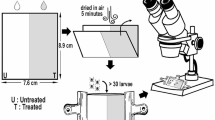Abstract
The oomycete Lagenidium giganteum, a facultative parasite of mosquito larvae requires exogenous sterols for the genesis of zoospores when grown saprobically. Growth media prepared from oil rich materials such as soy or sunflower seed were very effective inducers of virulent zoospores. The external morphology of zoospores of L. giganteum was studied with the aid of philips scanning electron microscope 515. Zoospores were ovoid, bluntly pointed with the groove parallel to the long axis and 0.7 × 1.4 μm. Insect cell walls are known to contain lipid and chitin. L. giganteum was tested for chitinase activity and found to possess 0.76 ± SD0.14 chitinase activity. Use of oil seed for growth of the organism confirms phospholipase activity. Phospholipase production was studied further by egg-yolk plate method. Presence of these two key enzymes that can initiate host cell damage suggests the entomopathogenic potential of L. giganteum. L. giganteum failed to grow at 37 °C limiting its effectiveness in warmer climates. Introduction of this organism to variety of habitats with various mosquito species will demonstrate the efficacy of the organism as a bioinsecticide.
Similar content being viewed by others
References
Kerwin JL, Deoborah AD, Robert KW. Pilot scale production and application in wildlife ponds of Lagenidium giganteum (Oomycetes: Lagenidiales). J Am Mosq Control Assoc 1994; 10(3): 451–455.
Jaronski ST, Axtell RC. Effects of temperature on infection, growth and zoosporogenesis of Lagenidium giganteum, a fungal pathogen of mosquito larvae. Mosq News 1983; 43: 42–45.
Domnas AJ, Srebro JP, Hicks BF. Sterol requirement for zoospore formation in the mosquito parasitizing fungus Lagenidium giganteum. Mycologia 1977; 69: 875–885.
Kerwin JL, Amy RT, Alison MW, Jennifer CW, Jessica JT, Misty LC, Joanna KM. Isoprenoid mediated changes in the glycerophospholipid molecular species of the sterol auxotrophic fungus Lagenidium giganteum. Microbiology (Reading) 1995; 141(2): 399–410.
Ferron P. Biological control of insect pests by entomogenus fungi. Ann Rev Entomol 1978; 23: 409–422.
Brey PT, Lebrun AG. External morphology of Lagenidium giganteum zoospores. Mycopathologia 1987; 97: 45–49.
Sur B, Bihari V, Sharma A, Basu SK. Survey of termiteinhabited soil and mosquito breeding sites in Lucknow, India for potential mycopathogens of Anopheles stephensi. Mycopathologia 1999; 144: 77–80.
Vidotto V, Leone R, Siniccco A, Ito-kuwa S, Crisco G. Comparison of phospholipase production in Cryptococcus neoformans isolates from AIDS patients and bird droppings. Mycopathologia 1998; 142: 71–76.
Mackichan JK, Amy RT, Kerwin JL. Preliminary characterization of phospholipase A2 in Lagenidium giganteum. Experimental Mycology 1994; 18(2): 180–192.
Grosso NR, Guzman CA. Lipid, protein and ash contents and fatty acid and sterol composition of peanut (Arachis hypogaea L.) seeds from Ecuador. Peanut Science 1995; 22(2): 84–89.
Mozzon M, Bocci F, Natale F. A study on the lipidic fraction extracted from high Oleic Sunflower seeds (Helianthus annuus L.) during the ripening process. J Agric Food Chem 1998; 46(10): 4198–4202.
Jaronski ST, Axtell RC. Simplified production system for the fungus Lagenidium giganteum for operational mosquito control. Mosquito News 1984; 44(3): 377–381.
Prosser JI, Tough AJ. Growth mechanisms and growth kinetics of filamentous microorganisms. Crit Rev Biotechnol 1991; 10: 253–274.
Conn EE, Stumpf PK. Outlines of Biochemistry. Wiley Eastern Limited 4th U.S. Edition, 1976; 378.
Clayton RB. The utilization of sterols by insects. J Lipid Res 1964; 5: 3–19.
Ho HH, Hickman CJ, Telford RW. The morphology of zoospores of Phytophthora megasperma var. sojae and other phycomycetes. Can J Bot 1967; 46: 88–89.
Author information
Authors and Affiliations
Rights and permissions
About this article
Cite this article
Sur, B., Bihari, V., Sharma, A. et al. Studies on physiology, zoospore morphology and entomopathogenic potential of the aquatic oomycete: Lagenidium giganteum . Mycopathologia 154, 51–54 (2002). https://doi.org/10.1023/A:1015273516881
Issue Date:
DOI: https://doi.org/10.1023/A:1015273516881




